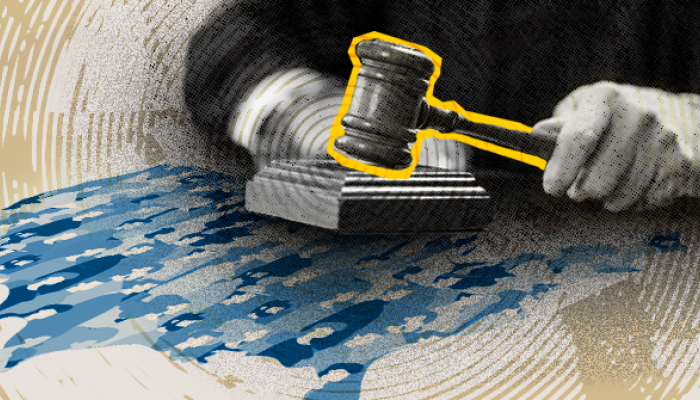Amid growing recognition of disparities in America’s justice system, this report highlights a critical but under-scrutinized problem: the lack of racial, ethnic, and gender diversity on state supreme court benches across the United States. State supreme courts, which sit atop state judiciaries, do not typically garner the same attention as the U.S. Supreme Court, but they hold substantial power. As a whole, state courts hear 95 percent of all cases filed in the United States. State supreme courts generally provide the final word in interpreting state law and set precedents that bind more than 23,000 lower state court judges.
In recent years, state supreme courts have reversed multimillion-dollar verdicts in commercial disputes, struck down restrictive abortion laws, and ordered hundreds of millions of dollars in additional funding for education — all as matters of state law.
Drawing on nearly 60 years of data, we looked at who has been empowered to don a robe and sit on these powerful courts. A few numbers begin to tell the story:
- Twenty-four states currently have an all-white supreme court bench, including eight states in which people of color are at least a quarter of the state’s general population.
- Only 15 percent of state supreme court seats nationwide are held by individuals who are Black, Asian, Latino, or Native American — though nearly 40 percent of the nation’s population are people of color.
- Since at least 1960, the earliest year for which we were able to obtain comprehensive data, 13 states have never seated a person of color as a justice, and six more states have only had one justice of color. More than a third of all states — 18 in total — have never seated a Black justice.
- Women hold only 36 percent of state supreme court seats. Currently, 17 states have only one female justice on their supreme court bench.
By some measures, state supreme courts are less reflective of the United States’ diversity than they were a generation ago. The gap between the proportion of people of color on the supreme court bench and their representation in the U.S. population was higher in 2017 (the most current year for which we have available population data) than it was over two decades ago, in 1996.
This deficit of diversity among judges threatens the legitimacy of the judiciary in the eyes of the communities it serves. As former Ohio Supreme Court Justice Yvette McGee Brown observed, “The public’s perception of justice suffers . . . when the only people of color in a courthouse are in handcuffs.” This is particularly so in light of the vast racial disparities in the American criminal justice system, where 1 in 3 Black men are incarcerated in their lifetimes, compared with 1 in 17 white A 2015 National Center for State Courts survey of public confidence in state courts found a “massive racial gap” in trust in the fairness of the courts, revealing a “deep distrust of courts among African Americans.”
An absence of judicial diversity also limits the perspectives available to inform judicial deliberations, undermining state courts’ ability to develop a legal jurisprudence for an increasingly diverse America. Research shows that judicial diversity enriches judicial decision-making, promotes public confidence in the judiciary, and establishes role models across demographic groups.
Many factors drive this, including a long history of racial and gender discrimination and inequities in access to law schools and the legal bar (see Part II, “A History of Discrimination and Structural Hurdles”). Women and people of color continue to be underrepresented in the legal profession, and prior research has found that structural barriers — including implicit and explicit biases, disparities in access to mentoring, and unequal work assignments — impact their advancement into leadership positions in the law, which can in turn impact who reaches the bench.
Using new data, this report breaks ground in analyzing how another factor may impact diversity on the bench: a state’s method of judicial selection. Our analysis reveals that judicial elections have rarely been a path for people of color to reach the supreme court bench. This is true even in states that use contested elections to choose their justices. In these states, interim appointments, which occur when a seat opens in the middle of a justice’s term, have been the principal path to the bench for justices of color — but not for white justices. (Our findings are limited to state supreme courts, and dynamics may differ in lower courts.) And as detailed in Parts III and IV, we find racial disparities in virtually every element of state supreme court elections, from who wins, to how frequently incumbent justices are challenged, to how much money candidates raise, to who is supported by special interest groups.
Diversity on state supreme courts is under-studied and under-scrutinized, in part due to a lack of data: few states collect this information or make it publicly available. This report helps fill that gap, documenting missing diversity in the makeup of state high court benches across the country. However, understanding the starkly inadequate number of people of color and women on state supreme court benches is only a first step. We hope these findings will add urgency to efforts to build and strengthen pipelines to law school and the bench for underrepresented communities, encourage reforms to make both judicial elections and appointments more open to a diverse set of candidates, and inform discussions about how states should choose their justices in the first instance. Building a more inclusive judiciary should be a priority — not just for our elected officials and law schools, but for all of us.

